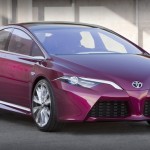
The next-generation Toyota Prius will get all-wheel-drive for the first time when it breaks cover next year – but the carmaker has retained the high rear end, low front and smooth roofline styling, essential to maintain the slippery 0.25Cd drag coefficient.
Toyota has gone to great lengths to disguise test mules, one pictured here by spy agency Automedia and draped in heavy black curtains. As usual, Toyota NZ won’t discuss the car, barely acknowledging that a new Prius is on the way.
What will it look like? It’s accepted that the petrol-electric hybrid will hold on to some of the styling cues seen in the NS4 concept at the 2012 Detroit motor show.
There are intended to give the Prius a more aggressive character. Slimmer headlights, LED ‘eyebrows’ and a wider and lower air intake will transform the front end. But the rear will be more Prius-like, to maintain the overall wedge shape.
The new Prius is the first model to be based on Toyota’s New Global Architecture, or TNGA platform. Toyota hopes the platform will cut development costs by 20 per cent to 30 per cent and help create more appealing products.
The carmaker’s research and development board member Mitsuhisa Kato told reporters in Europe that it “had the sense” that it was lagging behind companies like Volkswagen and Hyundai who have “very competitive new models” using global architecture.
There is of course a risk with such platforms, where common parts are used in multiple models. Get something wrong in one and a whole raft will need to be recalled, something that Toyota knows only too well after being hit by large-scale recalls in recent years.
But the TNGA platform has allowed Toyota’s engineers to develop an all-new hybrid synergy drive powertrain. A 1.8-litre four-cylinder Atkinson-cycle petrol engine and an electric motor will drive the front wheels, and another electric motor will drive the rear alloys.
The move to all-wheel-drive is to give the Prius more traction on slippery surfaces at slower speeds. It’s called ‘e-4WD’ but apparently only works up to 60km/h. Beyond that the rear electric motor disengages and the front wheels take over.
The set-up is expected to improve town-and-around fuel efficiency to 3 litres/100km (90mpg) and C02 exhaust emissions to around 40 grams per kilometer.
The 2015 Prius will almost certainly use lithium-ion batteries in place of the cheaper but bulkier nickel-metal hydride units, as used in the current Prius. Lithium-ion batteries cost more but have greater energy density.
Analysts say the significant quality upgrades inside the car and the rear electric motor for all-wheel-drive justify the cost. Overall, they say, the new Prius will be significantly more efficient.





